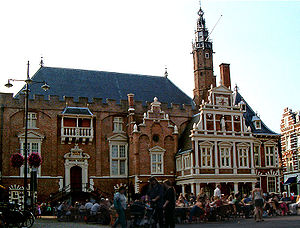
City Hall (Haarlem)
Encyclopedia

Haarlem
Haarlem is a municipality and a city in the Netherlands. It is the capital of the province of North Holland, the northern half of Holland, which at one time was the most powerful of the seven provinces of the Dutch Republic...
is the seat of the city's government.
History

After large fires in 1347 and 1351, William II, Count of Holland donated the remains of the Gravenzaal to the city's municipality. A new building was built there. The central square building dates from the Middle Ages, but the distinctive façade of the building was designed by architect Lieven de Key
Lieven de Key
Lieven de Key was a famous Dutch renaissance architect in the Netherlands, mostly known today for his works in Haarlem.-Biography:...
and built from 1602-1604. The way it originally looked can be seen in a painting from 1460 by the Master of Bellaert. Originally the city hall was just the front of the building, and the rear cloister belonged to the Dominican brotherhood. After the Protestant Reformation this came into the possession of the city council and it is now a large complex with offices and meeting rooms. Both the Frans Hals Museum
Frans Hals Museum
The Frans Hals Museum is a hofje and municipal museum in Haarlem, Netherlands. The museum was founded in 1862 in the newly renovated former cloister located in the back of the Haarlem city hall known as the Prinsenhof...
and the Haarlem Public Library originally were located in the city hall.
Every Saturday and Monday there is a big market in front of the City Hall, where on Saturdays mainly flowers, household goods, and food is sold, and on Mondays mainly cloth, and clothing. Although the market is frequented by the local population, it is a truly touristic attraction and worth a visit, if only to try the raw herring from the fish stand, or stroop wafels from the stroop wafel stand.
Inside
A large number of paintings and objects from Haarlem's rich history can be found inside the building. One series of paintings depict the various counts of HollandCount of Holland
The Counts of Holland ruled over the County of Holland in the Low Countries between the 10th and the 16th century.-House of Holland:The first count of Holland, Dirk I, was the son or foster-son of Gerolf, Count in Frisia...
, starting from Dirk I
Dirk I, Count of Holland
Dirk I was Count of Holland, thought to have been in office from ca. 896 to ca. 928 or 939.-'Count in Frisia':The actual title of count Dirk I was 'count in Friesland'....
to Maximilian from Austria
Maximilian I, Holy Roman Emperor
Maximilian I , the son of Frederick III, Holy Roman Emperor and Eleanor of Portugal, was King of the Romans from 1486 and Holy Roman Emperor from 1493 until his death, though he was never in fact crowned by the Pope, the journey to Rome always being too risky...
. In the Middle Ages these paintings were hanging in the Carmelieten Cloister in Haarlem; they were painted between 1486 and 1491. In 1570 it is mentioned in city archives that the paintings were hanging in the City Hall; possibly they were moved there in 1566 to protect them from the iconoclastic riots
Iconoclasm
Iconoclasm is the deliberate destruction of religious icons and other symbols or monuments, usually with religious or political motives. It is a frequent component of major political or religious changes...
. Other paintings and objects are either part of the original interior, or too big to fit in the Frans Hals Museum.

